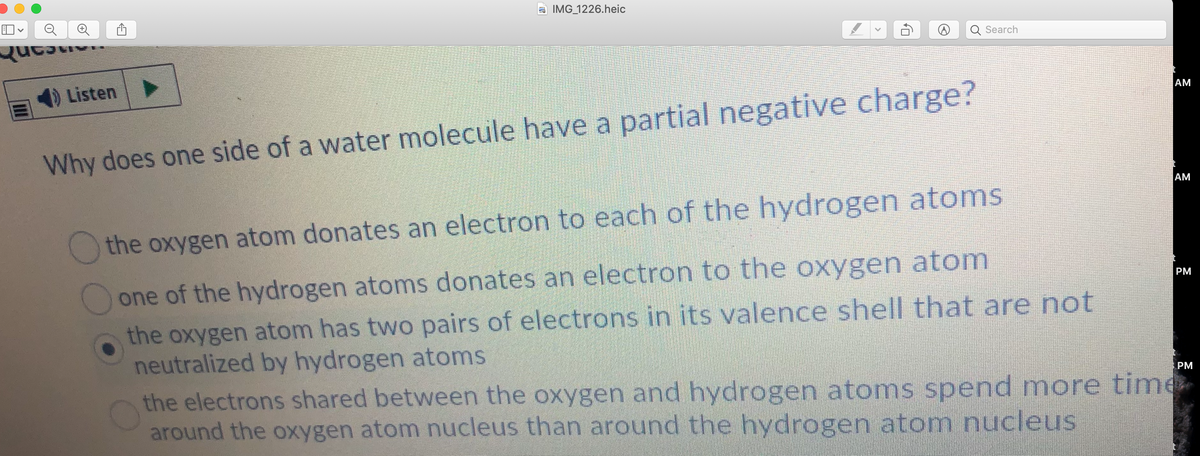IMG 1226.heic Search Listen AM Why does one side of a water molecule have a partial negative charge? AM Othe oxygen atom donates an electron to each of the hydrogen atoms one of the hydrogen atoms donates an electron to the oxygen atom the oxygen atom has two pairs of electrons in its valence shell that are not neutralized by hydrogen atoms the electrons shared between the oxygen and hydrogen atoms spend more time around the oxygen atom nucleus than around the hydrogen atom nucleus PМ PM
IMG 1226.heic Search Listen AM Why does one side of a water molecule have a partial negative charge? AM Othe oxygen atom donates an electron to each of the hydrogen atoms one of the hydrogen atoms donates an electron to the oxygen atom the oxygen atom has two pairs of electrons in its valence shell that are not neutralized by hydrogen atoms the electrons shared between the oxygen and hydrogen atoms spend more time around the oxygen atom nucleus than around the hydrogen atom nucleus PМ PM
Chapter8: Bonding: General Concepts
Section: Chapter Questions
Problem 24Q: Which of the following statements is/are true? Correct the false statements. a. It is impossible to...
Related questions
Question

Transcribed Image Text:IMG 1226.heic
Search
Listen
AM
Why does one side of a water molecule have a partial negative charge?
AM
Othe oxygen atom donates an electron to each of the hydrogen atoms
one of the hydrogen atoms donates an electron to the oxygen atom
the oxygen atom has two pairs of electrons in its valence shell that are not
neutralized by hydrogen atoms
the electrons shared between the oxygen and hydrogen atoms spend more time
around the oxygen atom nucleus than around the hydrogen atom nucleus
PМ
PM
Expert Solution
Development of partial charges on water molecules
In water molecule, Oxygen is bonded to Hydrogen atom through a shared pair of electron (i.e one electron is donated by oxygen and other by hydrogen. But due to greater electronegativity of oxygen atom (due to greater nuclear charge, i.e. 8 units of positive charge) than hydrogen (with only one unit of positive charge), shared pair of electron is pulled more strongly towards oxygen atom.
Hence, shared pair of electron spends more time around the more electronegative oxygen atom nucleus than around less electronegative hydrogen atom.
Hence, option D is correct.
Trending now
This is a popular solution!
Step by step
Solved in 2 steps with 1 images

Recommended textbooks for you


Chemistry
Chemistry
ISBN:
9781305957404
Author:
Steven S. Zumdahl, Susan A. Zumdahl, Donald J. DeCoste
Publisher:
Cengage Learning

Chemistry: An Atoms First Approach
Chemistry
ISBN:
9781305079243
Author:
Steven S. Zumdahl, Susan A. Zumdahl
Publisher:
Cengage Learning


Chemistry
Chemistry
ISBN:
9781305957404
Author:
Steven S. Zumdahl, Susan A. Zumdahl, Donald J. DeCoste
Publisher:
Cengage Learning

Chemistry: An Atoms First Approach
Chemistry
ISBN:
9781305079243
Author:
Steven S. Zumdahl, Susan A. Zumdahl
Publisher:
Cengage Learning


Chemistry: Principles and Practice
Chemistry
ISBN:
9780534420123
Author:
Daniel L. Reger, Scott R. Goode, David W. Ball, Edward Mercer
Publisher:
Cengage Learning

Chemistry: The Molecular Science
Chemistry
ISBN:
9781285199047
Author:
John W. Moore, Conrad L. Stanitski
Publisher:
Cengage Learning